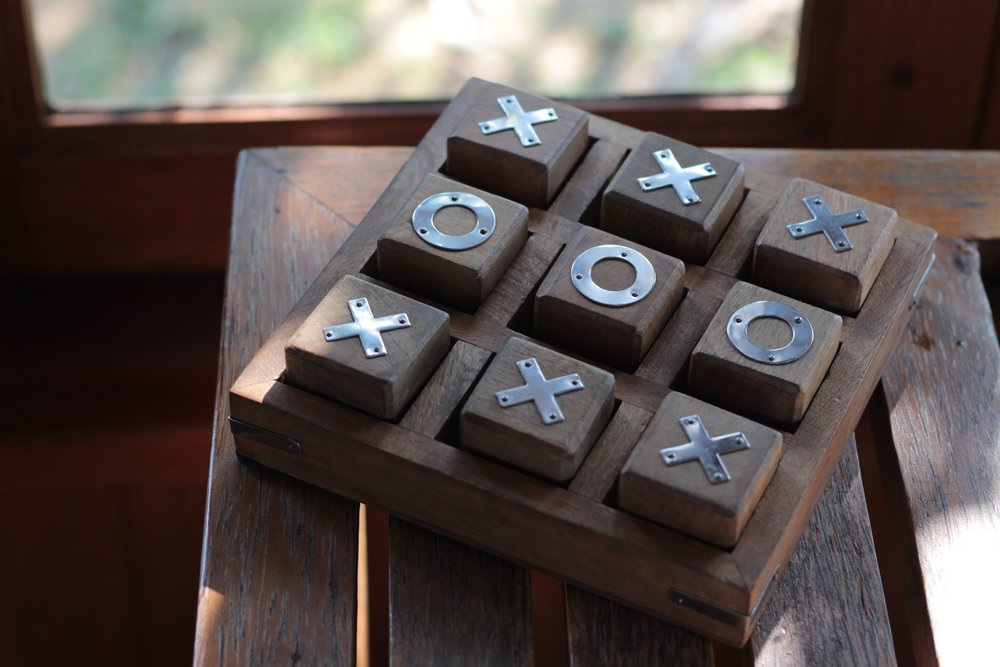Last Updated on January 25, 2024 by Gamesver Team and JC Franco

There’s one thing that many of us already know; there are some people that are very good at playing Tic-Tac-Toe. If you have ever found yourself wondering what their secret is, it might help you to know that it’s a solved game.
It’s a game that has a variety of solutions that can be learned. Once you know what the solutions are – and you end up playing with someone who doesn’t know the solutions – you have a high chance of winning every single time. Confident and victorious winners aren’t always skilled. Sometimes they’re just clever (or strategic) enough to enter the game well-equipped with the answers!
Many people wonder if Tic-Tac-Toe is a solved game, a zero-sum game, a fair game, or even a rigged game. Today we are going to explore each of these possible options.
Is Tic-Tac-Toe:
- A solved game? Tic-Tac-Toe is a solved game, which means that if both players play perfectly, the game will always end in a tie (draw).
- A zero-sum game? Tic-Tac-Toe is a “perfect information” zero-sum game.
- A fair game? Tic-Tac-Toe is not an entirely fair game in terms of the definition of a “fair” game.
- A rigged game? Tic-Tac-Toe is not a rigged game. It is not set up in a way to make winning difficult for players. There’s no real way to manipulate the game while playing under the correct rules.
In short, you now know that Tic-Tac-Toe is a solved game and a zero-sum game, but it is not a fair game. It is also not a rigged game. Read on if you want to delve into a bit more detail as to why and how these conclusions have been come to. Each type of game, and how Tic-Tac-Toe fits into those types, is explored in more detail below.
What Type of Game is Tic-Tac-Toe?
First and foremost, let’s clarify what Tic-Tac-Toe is.
The Oxford English Dictionary defines Tic-Tac-Toe as follows: “a game in which two players seek in alternate turns to complete a row, a column, or a diagonal with either three O’s or three X’s drawn in the spaces of a grid of nine squares.”
What we know about the game is that it’s probably far older than we think. Evidence shows an early version (ancestor) of Tic-Tac-Toe was a highly popular game in Ancient Rome (1st Century BC); it was known as “Terni Lapilli”. This can be deduced by the fact the game “Terni Lapilli” can be seen scratched and etched into many surfaces all over Rome.
The history of the game eludes us, but that doesn’t take away from the fact that we love it. The game’s following is phenomenal. In fact, there are very few people on the earth that may not know what Tic-Tac-Toe is.
For many, Tic-Tac-Toe is merely a fun paper and pencil game that anyone can play. It’s a great game to pass the time and get your head thinking a bit more clearly. For others, the people who really want to know more about the games that they are playing, more information is needed on what type of game it is. Below we explore what type of game Tic-Tac-Toe really is.
Is Tic-Tac-Toe a Solved Game?
This is a question many people have typed into a Google search at some point in their lives. The answer is yes, Tic-Tac-Toe is a solved game. When no silly mistakes are made by the players who already know the best moves to make, the game of Tic-Tac-Toe will always end in a draw. Why? Because the game is, in fact, solved.

There are various definitive solutions to the game that ends in a definite win. If both parties know these moves, it will end in a draw. By definition, a “solved game” is a game that always ends in a draw when there is perfect play.
If you’re not “in the know” and have no prior knowledge of the solutions to the game, it’s your lucky day! Today is the day you’ll learn how to play Tic-Tac-Toe for a definite win. Below are 2 solutions that you can learn and use in future games. Fingers crossed that your next opponent doesn’t know the solutions, too, so that you can end the game in a win for you!
1. Play first in a corner position.
Saying that you should play first in the corner position doesn’t mean that you have to make the first move, but it does help. It merely means that the first move you play (even if it is second to your opponent), you should place your mark in the corner position.
Let’s say you make the first move and place your X in the outer corner (any corner) square. It doesn’t matter where your opponent places their mark, because your next move should be to place your mark in another corner square. When you do this, you secure at least 2 direct next move wins.
If your opponent plays first and puts their mark anywhere, but in the middle square, you can still play out this move and win. If you learn this particular move, you have a high possibility of winning, especially if your opponent has never learned the winning moves to Tic-Tac-Toe.
2. Force a draw, if your opponent plays in the corner position.
If your opponent plays first by placing their mark in the corner position, don’t assume they already know the winning moves. Their first move could be an uninformed fluke. Keep calm and proceed to force a draw. At least they won’t be able to claim victory, right?!
Once your opponent has played their first move, place your mark in the middle square on the grid. Your next move should be to place your mark in a side square (not corner squares). These 2 moves should result in a tie.
Is Tic-Tac-Toe a Zero-Sum Game?
If you’re wondering if Tic-Tac-Toe is a zero-sum game, the answer is simple; yes, it is. If you take a look at the definition of “zero-sum game”, you will understand why this particular definition perfectly fits Tic-Tac-Toe.
A zero-sum game is where a player’s loss is equal to the other player’s gain. This means that what is lost is what is won. It fits in quite well with Tic-Tac-Toe because when one player wins, the other loses.
If you know the best moves of Tic-Tac-Toe, you won’t be able to lose. Much the same, if your opponent knows the best moves of Tic-Tac-Toe, they won’t be able to lose. If both know what they are doing, it will end in a tie, which only reiterates that Tic-Tac-Toe is a zero-sum game.
Is Tic-Tac-Toe a Fair Game?
If you’re looking for a fair game to play, Tic-Tac-Toe is not it. Once again, we must rely on the actual definition of the term. A “fair game” is defined as a game where there is as much chance of you winning as there is of you losing.

If both players play Tic-Tac-Toe carefully, the best outcome there could be is a draw. Also, the player who goes first has a higher chance of winning than the player who goes second. Because of this, Tic-Tac-Toe is not considered a particularly fair game.
Is Tic-Tac-Toe a Rigged Game?
Some people may think that Tic-Tac-Toe is rigged because there is a specific way to play in order to win or force a tie. Surely if the game has a solution, it must be rigged? Well, that’s not quite how it works.
The term “rigged game” is something that people often misunderstand. The pencil and paper game of Tic-Tac-Toe is not a rigged game as there is no real way for a person to cheat at the game.
When a game is “rigged”, it means that it has been manipulated in a fraudulent way to ensure that a certain team or player wins. With Tic-Tac-Toe, this is not the case. Either player can win if they know what the solutions are.
In closing
For many people, playing Tic-Tac-Toe is an age-old favorite. Maybe you played it as a kid while waiting for the evening hours to pass. Or maybe you even play it now on a video call as some form of company-wide team-building effort. Whatever the case may be, the fact of the matter is that Tic-Tac-Toe has been around for quite some time.
Those in the know are aware that the game is both solved and a zero-sum game, but it might have been news to learn that it is neither fair nor rigged. Now you can use your newfound knowledge on Tic-Tac-Toe to decide if you wish to dive into future games or not. Our guess is that you will!

